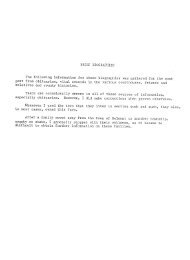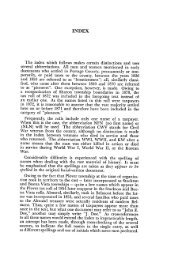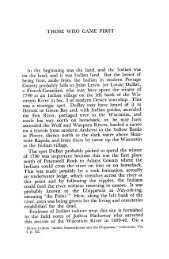NEW HOPE, THE TOWNSHIP OF Our Country Our Story ... - Library
NEW HOPE, THE TOWNSHIP OF Our Country Our Story ... - Library
NEW HOPE, THE TOWNSHIP OF Our Country Our Story ... - Library
Create successful ePaper yourself
Turn your PDF publications into a flip-book with our unique Google optimized e-Paper software.
<strong>NEW</strong> <strong>HOPE</strong>, The Towvnship of<br />
In a document written in long hand by a deputy<br />
clerk of Portage County on a rather ordinary piece of<br />
writing paper, it was announced that the County Board,<br />
at a meeting held Nov. 11, 1856 had determined "that<br />
all that portion of the county of Portage composed of<br />
Township twenty four (24) and twenty five (25) of<br />
Range ten (10) be and hereby is set off and shall for<br />
the purpose of town government constitute the town of<br />
New Hope and shall hold its first town meeting on the<br />
first Monday of December next at the house of Johann<br />
Oleson Hole."<br />
The circumstances of this document and the timing<br />
of the election for December rather than the following<br />
spring suggests that an extraordinary situation had<br />
arisen in eastern Portage County. A township of 72<br />
sections known as Peru (still pronounced "pee-roo" by<br />
some) had already been organized on April 1, 1856 at<br />
an election held at Frederick Reinhardt's house. Ole<br />
Olsen WVrolstad had been elected town chairman; Sondre<br />
Gunderson (Loberg) and Leonard Perry, supervisors;<br />
Ole 0. Wogsland, clerk; and Peder Halvorson<br />
(Houen), treasurer. But some question had arisen<br />
which caused this election to be considered, if not illegal,<br />
at least irregular. Probably this explains why the deputy<br />
clerk, who forgot to attach the County Board seal<br />
to the document, was in such a hurry when he sent out<br />
the notice of a special election. The new name of New<br />
Hope, replacing Peru, was allegedly suggested by Frederick<br />
Reinhardt, a German, and two Norwegians.<br />
Reinhardt was from Saxony. He entered the United<br />
States at New York on Aug. 23, 1849 and applied for<br />
naturalization at Plover on Dec. 27, 1853. It is quite<br />
possible that enroute to Portage County he spent
342 OUR COUNTY OUR STORY<br />
a short time with German acquaintances in or near<br />
New Hope, Pennsylvania, and from this experience<br />
suggested the same name for the township which he<br />
helped to organize.<br />
At the new election of the township, which fell on<br />
Dec. 12, 1856, Leonard Perry replaced Wrolstad as<br />
chairman while Wrrolstad and Simon Iverson were<br />
elected supervisors. John 0. Hole became town clerk<br />
as well as one of the assessors; Nils Stiansen the second<br />
assessor; Ole 0. Wogsland, John 0. Hole, Sondre Gunderson<br />
and George R. Lawton, justices of the peace;<br />
and Peter Peterson Kjaerra, treasurer. Apparently<br />
Kjaerra did not qualify as a later entry reveals that<br />
W~roistad had been appointed treasurer.<br />
The survey of the section lines was begun Jan. 24<br />
and completed Jan. 30, 1852.<br />
The glacial period dotted the town of New Hope<br />
with more lakes and pot holes than any other in the<br />
county, most of them in the east and southern sections<br />
where the rolling terrain aptly reflects the uneven<br />
struggle with nature. In fact, a town road between sections<br />
35 &e 36 runs into a kettle hole which the Norwegians<br />
since pioneer times have referred to as vrang<br />
hule, "the mean hole," not quite so noticeable today<br />
but still a hazard in winter driving.<br />
Sunset Lake, one of the most beautiful in central<br />
Wisconsin, is situated in Sec 22 of New Hope. None<br />
of the early plats ascribes a name to it and it was first<br />
identified as Sunset in the mid-1920s when a portion of<br />
the east shore was acquired by the Boy Scouts of America<br />
and since developed as Camp Chickagami ("Where<br />
camping is King,") playground of the Samoset Council<br />
with membership from all or part of 11 Wisconsin<br />
counties. And here a special Boy Scout order known as<br />
the Order of the Arrow has been established. Later,<br />
as if to confirm the mystic rites associated with the<br />
Order of the Arrow, it was discovered that at a certain<br />
time of day towards sunset, when the water mirrors the<br />
sky, that a person standing on the southeast shore, looking<br />
north, may discern a great arrow lying along the
<strong>NEW</strong> <strong>HOPE</strong>, <strong>THE</strong> <strong>TOWNSHIP</strong> <strong>OF</strong> 343<br />
north shore - an illusion created by the sandy beach<br />
which makes up the feathers, and the shore line which<br />
makes up the shaft, while the head of the arrow, lying<br />
to the east, is created both by the shore line and the<br />
reflection of the trees on a nearby hill.<br />
To the southeast of Sunset lies a small lake. The<br />
parsonage of the North New Hope Church was originally<br />
located on the same forty of land and the lake<br />
came to be called Praeste Laken (the preacher's lake)<br />
and is officially known today as Minister Lake.<br />
Farther east a few rods on the line between sections<br />
22 &e 23 lies a lake identified on recent plats as Skunk<br />
Lake, once known as "Valders Lake" after a man referred<br />
to by the early Norwegians as "Henrick Valders"<br />
who took the name of Larson in America.<br />
In sections 28 & 29 lies Reton Lake, no doubt after<br />
the J. 0. Reton family who later moved to Stevens<br />
Point. This lake also may have been known as Dutchman<br />
Lake in the 1870s, a name no longer used and<br />
while none of the early county plats, including 1915,<br />
designate it by any name, the 1957 plat calls it Reton<br />
which means that it has recaptured its first name. In<br />
1958 the lake was to all purposes dry.<br />
At the corner stake of sections 13, 14, 23 8e 24 lies<br />
a lake which was once known as Horton, probably after<br />
Cyrus Horton (mentioned in 1857 tax roll). The<br />
property nearby was later acquired by Peter Budsberg<br />
and the 1895 plat identifies this as Budsberg Lake, a<br />
name still used.<br />
Lying across the section line of 27 &c 34 is a lake<br />
which in pioneer times was called Reinhardt, no doubt<br />
after Frederick Reinhardt. Although it still retains its<br />
orginal name, it is often referred to locally as "Wolding<br />
Lake" after a nearby family. A short distance west in<br />
Sec 27 lies Onland Lake, after T. 0. Onland (or Onneland),<br />
also a pioneer of New Hope. One other named<br />
lake in the township lies in Sec 24 and is called Kankrud,<br />
after Hans P. Kankrud, but in 1958 was nearly<br />
dry. The western sections of the township are drained<br />
by the Tomorrow River and a feeder stream which
344 OUR COUNTY OUR STORY<br />
originates in the north of the township and is usually<br />
referred to as Mitcheltree Creek after the family of the<br />
same name living at the end of the town road. Eske<br />
Lodge, rendezvous of the Hot Shot Club from Stevens<br />
Point, is situated at the fork of Mitcheltree Creek where<br />
it joins the main stream of the Tomorrow River.<br />
When the water level in the township is up to normal,<br />
a small stream also drains Reinhardt Lake andi<br />
runs through sections 35 &z 36 into the South Branch<br />
of the Little Wiolf in the town of lola.<br />
Although Town 25 (Alban) was under the jurisdiction<br />
of New Hope until 1878, only six men in 1857<br />
paid taxes on land in Town 25 and none of them lived<br />
there. The following taxpayers are listed in the New<br />
Hope assessment of 1857: Peder Pedrsen Kieara, Nils<br />
Stiansen, Leonard Perry, Ole Olsen Hole, Amund<br />
Olsen Hole, Simen Blihovde, Rasmus Andersen, Oluf<br />
Pedersen, Svenning Andersen, Knudt Hansen, Thor<br />
Amunsen, Lars Nilsen, Andrew Olsen, Banjamin P.<br />
Pattersen, Anders Johnsen, Edward Pattersen, Giarul<br />
Gunstensen, Johan Olesen Reton, Gunder Olsen, Edward<br />
Halgesen, David J. Sanders, Wasington Sanders,<br />
Handrick Nilsen, Hans Kankrud, Lars Iversen, Ole<br />
Gaarden, Helik 0. Foss, Ole 0. Foss, Amund Mortensen,<br />
Endre Nilsen, Wiliem Barger, Amun Torgersen,<br />
Aslak Olsen, Ole Aslaksen, Knudt Sakariasen, John<br />
Iversen, Simen Iversen, Ole Iversen, Lars Johansen,<br />
Ole Gundersen, Georg Lotow (probably Lawton),<br />
Olaves Lund, Ole 0. Wogslan, Anloug Elefsen, Claus<br />
Gundersen, Gunder Nilsen, Gulbran Larssen, Hans<br />
Olsen, Ole Olsen Wrroistad, Peder Knudtsen, Halvor<br />
Borsen, Thomas Osmusen, Lars Andersen, Frederick<br />
Reinhardt, Handry (probably Henry) Wentsed, Ole<br />
Guliksen, Jorgen Pedersen, Cyas (probably Cyrus)<br />
Horton, Andru J. Horton, Johanes M. Aamot, Jens<br />
Houen, Osmund Gundersen, Hans Danielsen, Matis<br />
Halvorsen, Ole Tolefsen, Rasmus Andersen, Halvor<br />
Rolefsen, Johan A. Johansen, Sondre Gundersen, Jens<br />
J ohansen, Reiar Halvorsen, Jacob Jacobsen, Nils Evensen,<br />
Peder Halvorsen, Ole Halvorsen, Thomas Nilsen,
<strong>NEW</strong>T <strong>HOPE</strong>, <strong>THE</strong> TO'WNSHIP <strong>OF</strong> 345<br />
Kjel Johanesen, Torsten Rasmusen, Hans Olsen Lee,<br />
Ole Ostensen, Nils Andersen and Ole Johanesen.<br />
The majority of these taxpayers were probably residents<br />
of New Hope. Although New Hope became the<br />
most heavily populated Norwegian township in Portage<br />
County there were, in the beginning, a few English or<br />
Yankee settlers here such as the Pattersons and Sanders, in<br />
addition to Horton, Perry, and Lawton. Most of them<br />
left New Hope within a few years, probably to avoid<br />
being absorbed completely by Norse culture. Leonard<br />
Perry, for example, moved south to Lanark where he<br />
could be among Scotsmen and Englishmen who referred<br />
to "tea" as supper, not a mid-afternoon snack<br />
(kaffe-tid).<br />
The first Polish settlers in New Hope were probably<br />
John Domaszek and John Gladowski. Both paid taxes<br />
in 1868 on land in Sec 7 and perhaps settled here before<br />
that time.<br />
As there is no village in New Hope, several country<br />
stores became local landmarks. Probably the most<br />
noted was located in the southeast corner of the township<br />
at a place known before and after the turn of the<br />
century as Benson Corners (H- 161) more recently referred<br />
to on a highway sign as "New Hope." That the<br />
highway department reverted in mid-1950 in its road<br />
legend to this name suggests that it may have been the<br />
original name of the community, even as the 1895 plat<br />
identifies it. When a post office was established here<br />
on Aug. 13, 1861, it was, in fact, called New Hope.<br />
Frederick Reinhardt served as the first postmaster.<br />
Wrhen it was discontinued in 1904 the name Benson<br />
Corners gradually replaced the name of New Hope,<br />
probably because of the confusion which arose over<br />
the two entities. Peer Benson operated a store here in<br />
the 1 870s and advertised in the 1876 plat as a dealer in<br />
"dry goods, groceries, hats, caps, boots, shoes, clothing,<br />
notions, etc." The store site is first referred to at a<br />
meeting of the town board held "at the store of J.<br />
Endlick" on May 11, 1863. In 1958 it stood vacant<br />
after nearly a century of service.
346 OUR COUNTY OUR STORY<br />
In the 1930s a novel was written by George V. Martin<br />
called "For <strong>Our</strong> Vines Have Tender Grapes" which<br />
used the region around Benson Corners as the locale<br />
of the story. It was later made into a motion picture.<br />
On April 11, 1865 the town board held a meeting<br />
in ' (?) Store." The wording is illegible and the name<br />
could be Syverson or Evenson. Nils Evensen paid taxes<br />
in 1865 on $800 of personal property and as this kind<br />
of money usually represented a store building, it may<br />
be that Evensen operated a store located north of Onland<br />
Lake in Sec 26.<br />
Another early country store was operated by Ole 0.<br />
Wogsland south of Peru on Trunk T. A post office,<br />
called Alban, in honor of James S. Alban of Plover, was<br />
established in northern New Hope on Jan. 29, 1873<br />
with Ole 0. Wogsland as postmaster. Veterans of the<br />
township agree that this was located south of Peru on<br />
what is still the Walter Wogsland farm. The post<br />
office, still calling itself Alban, was moved into the<br />
town of Alban in 1880. The first reference, however,<br />
to Wogsland's store appears in 1868 when the town<br />
board met there.<br />
Another country store, noted in the early days for<br />
its pot-bellied stove, cracker barrel, spitoons and peanutshucks-all-over-the-floor,<br />
was built in the early 1 880s in<br />
the west of the township at the intersection of Trunks<br />
A Sc Z. The building may have been erected by Sgvart<br />
T. Foxen when he purchased the lot on the northeast<br />
corner in 1882, for it was here that a post office, called<br />
Garfield, no doubt after the president, was established<br />
on March 19, 1884 with Foxen serving as postmaster.<br />
While the post office was discontinued Oct. 15, 1907,<br />
the store has since been known as the Garfield Store.<br />
Foxen passed it on to Amund Mortensen in 1892.<br />
Whether he actually operated the store is uncertain.<br />
The heirs of Mortensen sold to John A. Hole in 1896<br />
when the store was operated mostly by son John and<br />
later Edwin, probably down to 1914, when Martin<br />
Ingbretson took over for about a year. By this time<br />
the old building was quite dilapidated and the store<br />
was closed for several years. The property was sold in
<strong>NEW</strong>V <strong>HOPE</strong>, THIE TOWrNSHIP <strong>OF</strong> 347<br />
1920 to Joseph Omernik who erected a new building.<br />
Around 1925 son Alex began operating the store for his<br />
father, in 1927 became the owner and has continued<br />
in business since that time.<br />
The Peru Store, at the junction of Trunks T Sc Z,<br />
was started in the early 1 880s by Oscar Wroistad. This<br />
may have followed the establishment of a post office on<br />
Sept. 14, 1882, called Peru, in the home of Martin 0.<br />
Wrolstad who lived a few rods northeast of the present<br />
store. The post office was temporarily discontinued<br />
Nov. 28, 1884, opened again Jan. 7, 1885 and continued<br />
down to Oct. 15, 1907 when it was closed. The<br />
Peru store, operated throughout this period by Oscar<br />
Wrrolstad, was sold to Alfred M. Wrrolstad in 1912. In<br />
1947 it was taken over briefly by Elvin Wrrolstad and<br />
later by a brother, Franklin Wrolstad. In June 1948<br />
Allen Torbenson became the owner and has continued<br />
in business since that time.<br />
A farmer's co-op creamery was established across the<br />
road (west) from the store around the turn of the century.<br />
It eventually became a cheese factory which was<br />
discontinued after Wrorld Wrar II.<br />
In 1958 what is considered to be one of the finest<br />
stands of second-growth white pine in northern Wisconsin<br />
is located east of Garfield on a forty owned by<br />
Joseph Ostrowski (NW¼/-NW¼/, Sec 10). It was<br />
probably logged off in the 1 870s and, owing to the fact<br />
that it was and still is a "back forty," that is, removed<br />
from any town or county road, it became in a sense<br />
isolated and was allowed to re-seed itself. -Except for<br />
recent select cuttings, it has remained untouched for<br />
some 80 years. In this wood lot one can sense the great<br />
dignity and splendid isolation of the white pine - the<br />
tree that helped establish a new civilization in Portage<br />
County.<br />
In the northeast corner of the township, J. Melvin<br />
Rustad also has a stand of timber which is among the<br />
finest in central Wrisconsin. A white cedar located on<br />
this wood lot is the largest in the state. It was officially<br />
measured by State Forest Ranger William Peterson in<br />
1958 and scaled ten feet and six inches in circumfer-
348 OUR COUNTY OUR STORY<br />
ence four and a half feet from the ground. One of the<br />
tallest white spruce trees in the state is also growing<br />
nearby.<br />
Serving the town of New Hope, with a population of<br />
608, in 1957-58, were Russell Krogwold, chairman; Sam<br />
Larson and Peter Hintz, supervisors; Arthur Stoltenberg,<br />
clerk; Alex Omernick, treasurer; Franklin Wrolstad,<br />
assessor; and Dr. V. A. Benn, health officer.
.<br />
.<br />
.<br />
<strong>Our</strong> <strong>Country</strong> <strong>Our</strong> <strong>Story</strong> Portage County Wisconsin - Link Page<br />
PREVIOUS...NELSONVILLE, <strong>THE</strong> VILLAGE <strong>OF</strong>.................................................................335<br />
NEXT.......PARK RIDGE, <strong>THE</strong> VILLAGE <strong>OF</strong>..................................................................349<br />
GO BACK TO <strong>THE</strong> ELECTRONIC INDEX PAGE...<br />
<strong>Our</strong> <strong>Country</strong> <strong>Our</strong> <strong>Story</strong> Portage County Wisconsin - Link Page
















